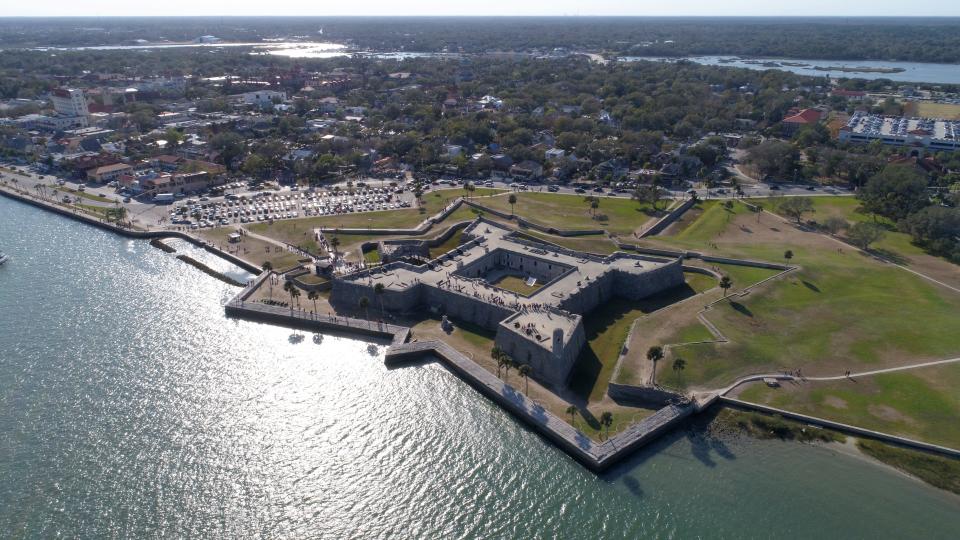Happy 350th birthday to Castillo de San Marcos | Susan Parker
- Oops!Something went wrong.Please try again later.
Next Sunday marks the 350th anniversary of the groundbreaking that began the building of Castillo de San Marcos. At 4 o'clock in the afternoon of Oct. 2, 1672 ( also a Sunday), Florida Gov. Manuel de Cendoya thrust a shovel into the ground to being the building of the fortification. The fort's role was to protect the capital of Spanish Florida, our city of St. Augustine from capture. Its role was also to provide shelter for the residents of St. Augustine during an attack.
A little more than a month later Cendoya laid the first coquina stone of the foundation. Cendoya was the governor who finally oversaw the beginning of the long-hoped-for masonry fortification.
Susan Parker: A history of the cannon at Castillo de San Marcos in St. Augustine
Susan Parker: Story of Christmas in Castillo de San Marcos in St. Augustine
For almost a century Spanish Florida officials had requested, even pleaded, for the authorization and funding to build a masonry defense structure instead of one made of wood. Pedro Menendez Marquez, nephew of St. Augustine's founder Pedro Menendez de Aviles, reported that in 1580 he had seen outcroppings of coquina on Anastasia Island. He suggested that the material, composed of coquina clam shells, would make a fine fortification.
In Northeast Florida the term coquina refers to the shell stone waiting not far below the surface of the ground. St. Augustine is the northernmost limit of coquina on the Atlantic coast. Coquina is found in a number of locations south of our city. But coquina is a generic term for shell stone or loose shells. The word is used in many other locations. The drive in front of the colonial Tryon Palace (formerly Governor's Palace) in Newbern, N.C., has been described as paved with coquina.
St. Augustine lacked the number of workers needed to build the project. The soldiers who lived and served in St. Augustine already had assigned schedules for guard duty. They were not available usually to work on the fort. Some workmen skilled in masonry construction had to be brought into our city.
Indians from the Spanish Florida missions were conscripted to work on the fortress. The Indian laborers came to work here for a supposedly specific period of time, but the period of service was often extended. Some brought their families with them, others came by themselves. Either way, their villages were deprived of the their contributions to growing food and other needed work.

Susan Parker: Castillo de San Marcos is full of history
Susan Parker: Plains Native Americans memorialized their captivity in St. Augustine with art
Slideshow: A day at the Castillo de San Marcos
At first the Castillo building project must have seemed cursed. Gov. Cendoya and the engineer in charge of the project, Ignacio Daza, both died within a year. The building project moved in fits and starts, with long periods of inactivity.
At last, the first phase of the construction was completed in 1695 at almost twice the original budget. Workers then moved their attention to building a coquina sea wall.
Castillo de San Marcos still looms over the city and is its most recognizable landmark, among so many other important sites. For us residents, it is often just a part of our landscape. We probably seldom think about the larger effect on history of the presence of the Castillo--on the history of the region and the nation.
Seven years after completion, the Castillo prevented English invaders in 1702 from holding St. Augustine and thus claiming the Spanish colony of Florida for England. English militia troops occupied St. Augustine on November 10 and stayed for more than six weeks. They retreated on December 29.
How different would history have been if the Florida peninsula had come under English control at that time? The English would have controlled the shores where the Gulf Stream comes closest to the mainland. The English would have controlled the sea lanes, able to easily attack Spanish ships filled with goods of the Americas headed not just to Spain but to Europe as well.
England would have had easier access to control the mouth of the Mississippi River, Mexico, Cuba and the island of Hispaniola. We can see with our hindsight how history hung in the balance while the residents of St. Augustine, refuged in the then 30-years old Castillo waited out the English who occupied St. Augustine in late 1702.

Susan R. Parker holds a doctorate in colonial history.
This article originally appeared on St. Augustine Record: Spanish broke ground on Castillo de San Marcos 350 years ago on bayfront

